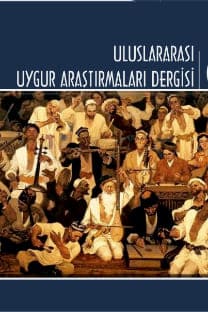UYGUR TÜRKLERİNDE ÖLÜM İLE İLGİLİ İNANIŞ VE ADETLER
Bilindiği gibi, ölüm insanın fiziki dünyadan metafizik dünyaya geçişini sağlayan bir olgudur. İnsan öldükten sonra metafizik dünyada ruh/ervah olarak yaşamaya devam eder. Ölenin öbür dünyaya rahat geçmesi ve orada huzurlu yaşaması için örf ve adetlere, dini kurallara uygun bir şekilde uğurlanması ve defnedilmesi gerekmektedir. Ölümle ilgili örf adetlerin tespiti ve sistematiğinin incelenmesi bu bağlamda büyük önem arz eder. Türklerdeki ölüm, ölü ve ruhla ilgili uygulama, inanç ve adetlerin geçmişini Çin kaynaklarından ve Orkun Yazıtlarından takip edebilmekteyiz. Eski Türklerde ölüm ruhun bedeni terk etmesiyle meydana gelir. Ruh, ölüm anında kuş olarak uçup gider. Ölü yuğ/cenaze töreniyle defnedilir. Yoğçı / sığıtçılar yas tutarlar. Ölen için yuğ/ölü aşı verilir. Bu temel şema bugün de pek fazla değişmiş değildir. Ancak farklı din ve kültürlerin etkisiyle bazı biçimsel değişiklikler söz konusu olmuştur. Uygurlar, geçmişten günümüze en çok din değiştirmiş Türk boylarından birisidir. Dolayısıyla Uygur Türklerinin kültürü çok katmanlı senkretik bir özelliğe sahiptir. Bu özellik Uygur Türklerinin ölüm olgusu etrafında oluşan örf ve adetlerinde de açıkça görülmektedir. Bu örf ve adetler, genelde diğer Türk boyları arasındaki örf ve adetlerle benzerlik göstermekle birlikte, özelde kendine has bazı hususiyetlere de sahiptir. Ölenin ardından yüksek sesle ağlanması, beyaz kuşak ve beyaz başörtüsünün yas işareti olarak kullanılması, mezar başında çırağ ve ateş yakılması, mezara koç boynuzu, dağ keçisi boynuzu, at kafası konulması, çaput bağlanması, mezarın beşik biçiminde yapılması, "üç nezir", "yette nezir", "kırkı nezir", "yıl nezir" adları altında ölü aşı/yemeği verilmesi, yağ koklatılması, ölen için Kur'an okunup dua edilmesi gibi hususlarda bu genel ve özel durumu gözlemlemek mümkündür. Bu makale, Uygur Türklerindeki ölüm, ölü, ruh/ervahla ilgili oluşan inanış ve adetlerin genel ve özel durumları hakkındadır
THE BLİEFS AND PRACTICES RELATED TO DEATH IN UYGHUR TURKS
As it is known, death is a phenomenon that provides a person’s passage from the physical world to the metaphysical one. After people dies, they continue to live as a spirit in the metaphysical world. In order to provide a comfortable passage for the dead person to the other world and to make him/her to live there in peace, they have to be sent off and buried in accordance with customs, practices and religious rules. In this context, great importance is placed on the determination of customs and practices concerning death and examination of its systematic. We are able to observe the background of practices, belief and customs related to death, dead and spirit in Turkic people from Chinese sources and the Orkun Writings. Among ancient Turks, death is occurred when spirit leaves from the body. At the moment of death, the spirit flies away and departs in manner of a bird. Dead person is buried by a funeral ceremony. Mourners lament and cry. Food is given on behalf of the dead person. Today, this basic pattern has not changed very much. However, certain formal alterations have taken place resulting from the effects of different religions and cultures.. Uyghurs are one of the Turkic tribes who have changed their religious practices most frequently from past till present..Therefore, the characteristics of a multilayer syncretism can be observed in Uyghur culture. These characteristics can be clearly observed also in the customs and practices of the Uyghur Turks that are formed around the phenomenon of death. On one hand these customs and practices show similarities with the customs and practices that are generally observed among the other Turkic tribes, on the other hand they also have a few characteristics that are particular and unique to them. It is possible to observe these general and special incidences in practices like the following: wailing and lamentingloudly for the dead person, lighting of fire at the head of the grave, using of white belts or sahses and white head coverings as a sign of mourning, mounting of a ram or mountain goat’s horn or attaching a cloth to a grave, making of a grave into the form of a cradle, giving of memorial food under the names ‘three offering,’ ‘yette offering, ‘forty offering,’ and ‘year offering,’ using scenting oil, and reading Kur’an and praying on behalf of the dead person. This article is about the general and specific situations of customs and practices concerning death, the dead, and the spirit are formed among the Uyghur Turks.
